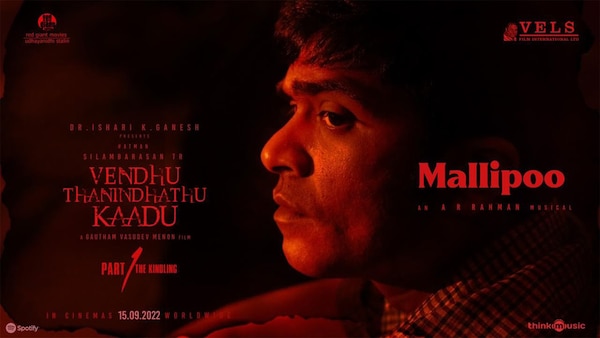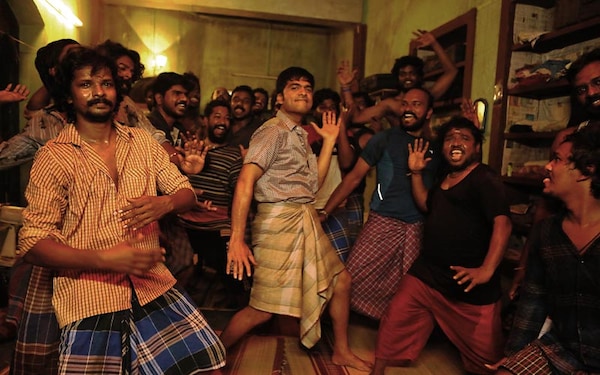Inside Mallipoo: How The Remarkable VTK Song Was Shot

- Sruthi Ganapathy
Film Companion
Last Updated: 05.49 PM, Sep 21, 2022

AR Rahman’s ‘Mallipoo’ plays out very intrinsically in Gautham Vasudev Menon’s Vendhu Thanindhathu Kaadu. It is a normal night at the Essaki parotta shop. The men are winding down after a long day, peering at their mobile phones and speaking to their loved ones, clutching onto the hopes of meeting them one day. And when one of them (actor Phathmen) asks his wife to sing a song to salve his pain, Mallipoo pulsates through the phone, and seamlessly permeates into the film. The lullaby, which evokes feelings of yearning and brotherhood, has been finding its way into people’s hearts not just for Rahman’s composition, but also for its unique staging.
‘Mallipoo’, which was shot as a single-shot sequence, sits right in the middle of VTK’s universe. Cinematographer Siddhartha Nuni, inspired by the French New Wave Movement, looked at creating a very naturalistic visual grammar for the film, and in particular, the song. “I wanted the audience to basically experience the nights in Bombay because most of the film is set in the nights. The motivation for the reds and the colours of VTK is motivated by the environment of the sets, the architecture,” he says.
From using the lights of the mobile phones to fall on actors’ faces to manipulating the lights on set to evoke emotions of hope in the song, it was an extremely challenging technical exercise, Nuni recalls. “It is a song which is hopeful in their dreary lives. It had to look pleasing. Till the song begins, the lighting is different. The windows are open before the song, but once it starts, it goes into a soft zone. When the camera starts moving from the face of Phathmen, the camera goes to the face of the people sitting in front of him, and then pans into the room. In that pan, we closed the windows so that the light became much softer.”
For the director of choreography Brindha Gopal, the biggest challenge was the space constraints. The song was filmed on a set erected by art director Rajeevan in Chennai. “When I went to the place, I was like ‘oh my god, how will we do one-shot in such a small place?” I spent around five minutes by myself on the set to figure it all out. And then I did a few rehearsals with them. All of them were non-dancers. We then started shooting the next day at around 6.30 (pm). And we finished the song within 2-3 takes,” she adds.

Even if Silambarasan is a natural dancer, the choreography had to stay real to the film’s world, she notes. “Everybody knows that Simbu is a great dancer. There is no form of dance that he can’t crack. But the challenge was to make his steps look natural. For instance, in ‘Uyirin Uyire’ from Kaakha Kaakha (2003), I would not have made Suriya dance, but only Jo. Because he plays an inspector in the film. If we lose the essence of what the character is, it would have become a usual song.”
The set’s confined space — which depicted the suffocating living conditions of Muthu (Silambarasan) and gang in the film — also meant that Brindha master and Nuni could not be present on the set during filming. “There was no place to move the camera on set. Idichitu dhaan naanga camera va move pannuvom. There was only space for one person to walk on the set because both sides of the set were packed with people,” recalls Brindha, who along with Nuni, was directing the song from outside.
This is where the gimbal operator and the focus puller come in, Nuni adds. “They had to really learn the song themselves because they were the ones inside the set, and Brinda ma’am was communicating with them constantly from the outside, telling them their movements. They needed to become dancers themselves.”
The single-take, a technique that the film uses for many of its scenes, was a gradual experiment, Nuni says. “One of the first times we attempted a long take was when Simbu’s character enters the top floor of the parotta shop. The camera goes behind him. With long takes, the main challenge is to avoid shadows, because when the camera moves, the shadow of the camera falls on the characters.”
The song, which has poignant lyrics of longing and distress, is also a slow song. “For a song like this, the camera must dance more than the performers. That is where you get the energy from,” says Brindha. Nuni agrees. The DOP settled for a fly-on-the-wall treatment to take the audiences as close to Muthu and the men’s life as possible. “The guys are up and dancing, but the camera work is just capturing the truth of the moment through close ups and a lot of mid shots. Most of my work is subconscious.”
The crew registered the power of shooting something like this on a single take, moments after the song was filmed. “Everybody on set just broke into a roar of applause. That moment was so joyful and powerful. That is when I realised we were onto something special,” beams Brindha.

 Premium
Premium